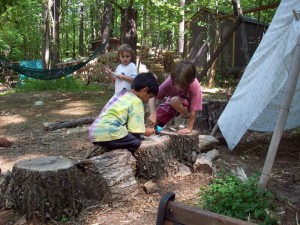
One of The Rose Garden parents sent me this photo yesterday. The exquisite beauty of the young child’s connection to nature is so evident: these brothers are free and at-large in the woods….living a life larger than the confines of their small bodies. They are as large as their own imaginations, at home in the forest. I am reminded of something I wrote years ago, as I prepared to write Heaven on Earth:
“I have found in my many years of teaching young children, and in my years as a mother of young boys, that most children are happiest at play outdoors. Young children are close to the realm of nature because they are still very natural beings. Because their consciousness is not yet separated from the environment, because they still live in the consciousness of oneness, of unity, they belong still to the natural world. In time they will belong to themselves, as the process of individuation becomes complete. But for about the first seven years, they are still at one with the world they inhabit. The process of separating from the parents and from the environment buds only around age seven. Before that, the child is moved along by life, something like the way a tree’s leaves dance in the breeze. The young child responds to the environment in a very unself-conscious way, a very natural way, and the open, complex, and diverse environment of the outdoors gives him that opportunity. If, in his excitement at a butterfly, he needs to dance and pirouette dizzyingly around the garden, no one has to say, “Be careful of the table.” If he needs to shout for glee or weep for sorrow, he is free.”
Through play in the natural world, we give our child the gift of freedom, tethered by and rooted in a deep visceral relationship. Is that not the fundamental balance humanity strives for? Such joy!



